07. All about Synthetic Call, Synthetic Put and Long Combo

The flexibility that options offer as an instrument makes them the instrument of choice for most traders. In this chapter, we will look at how a Call and Put option can be created using other instruments and also use a combination of call and put into creating a Long Combo.
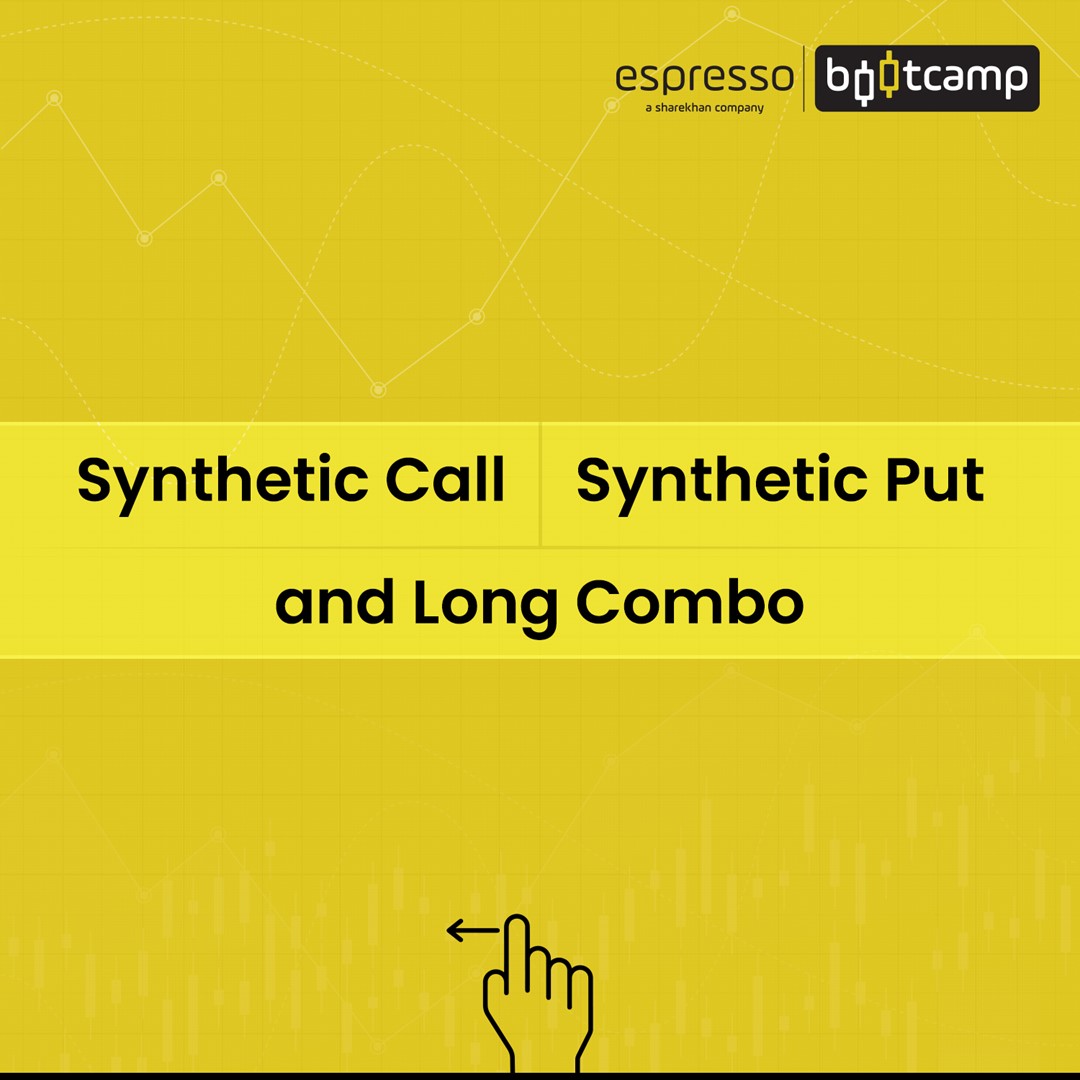
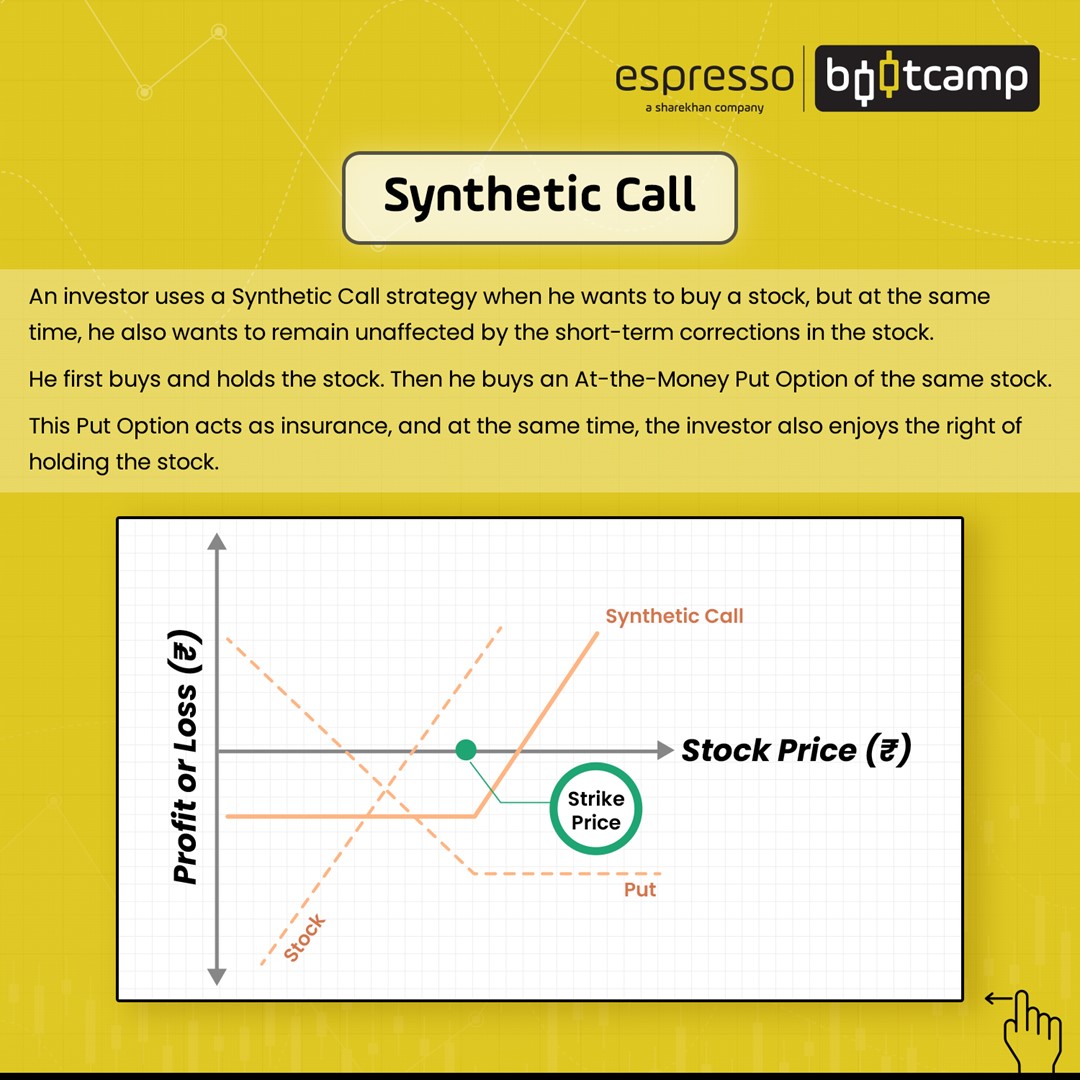
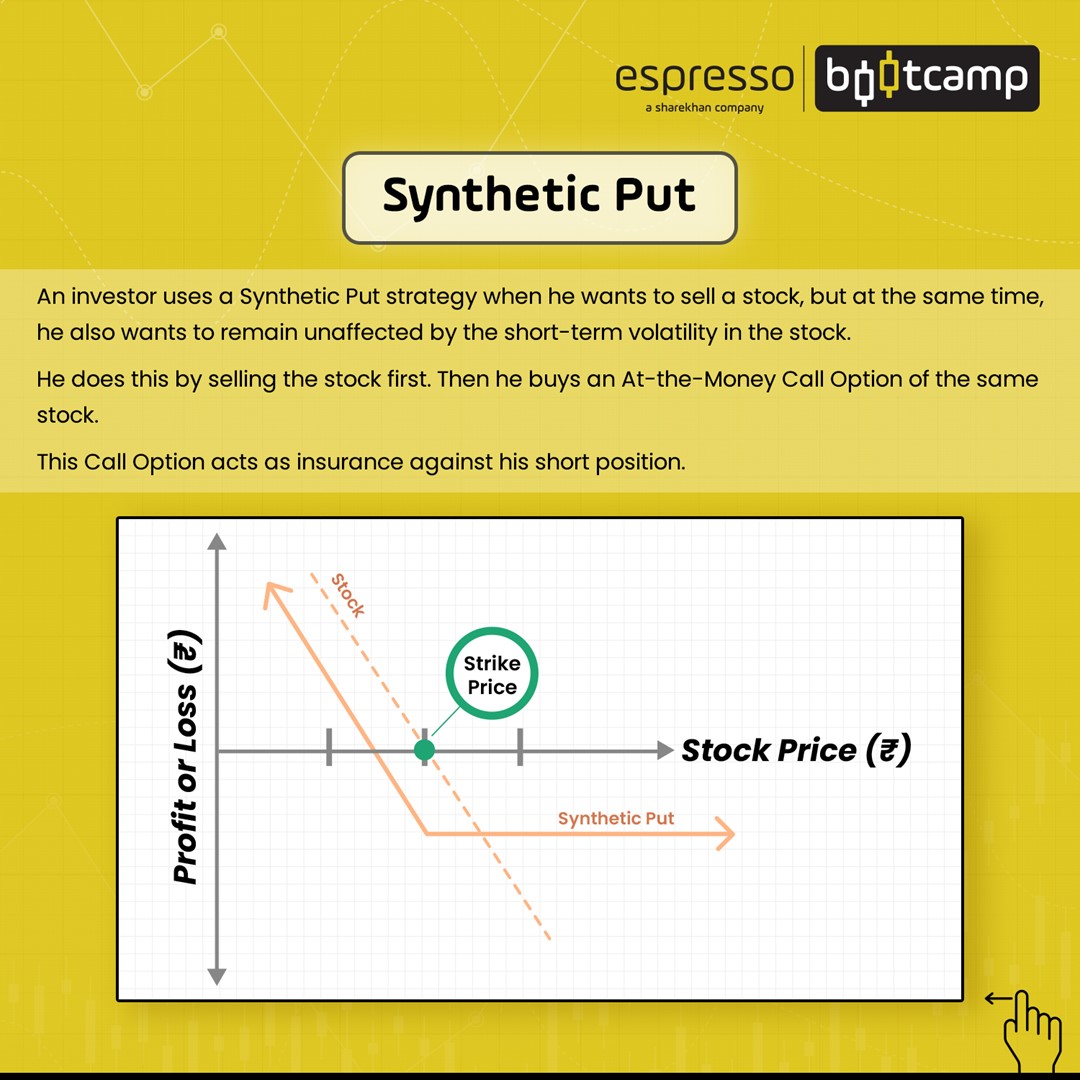
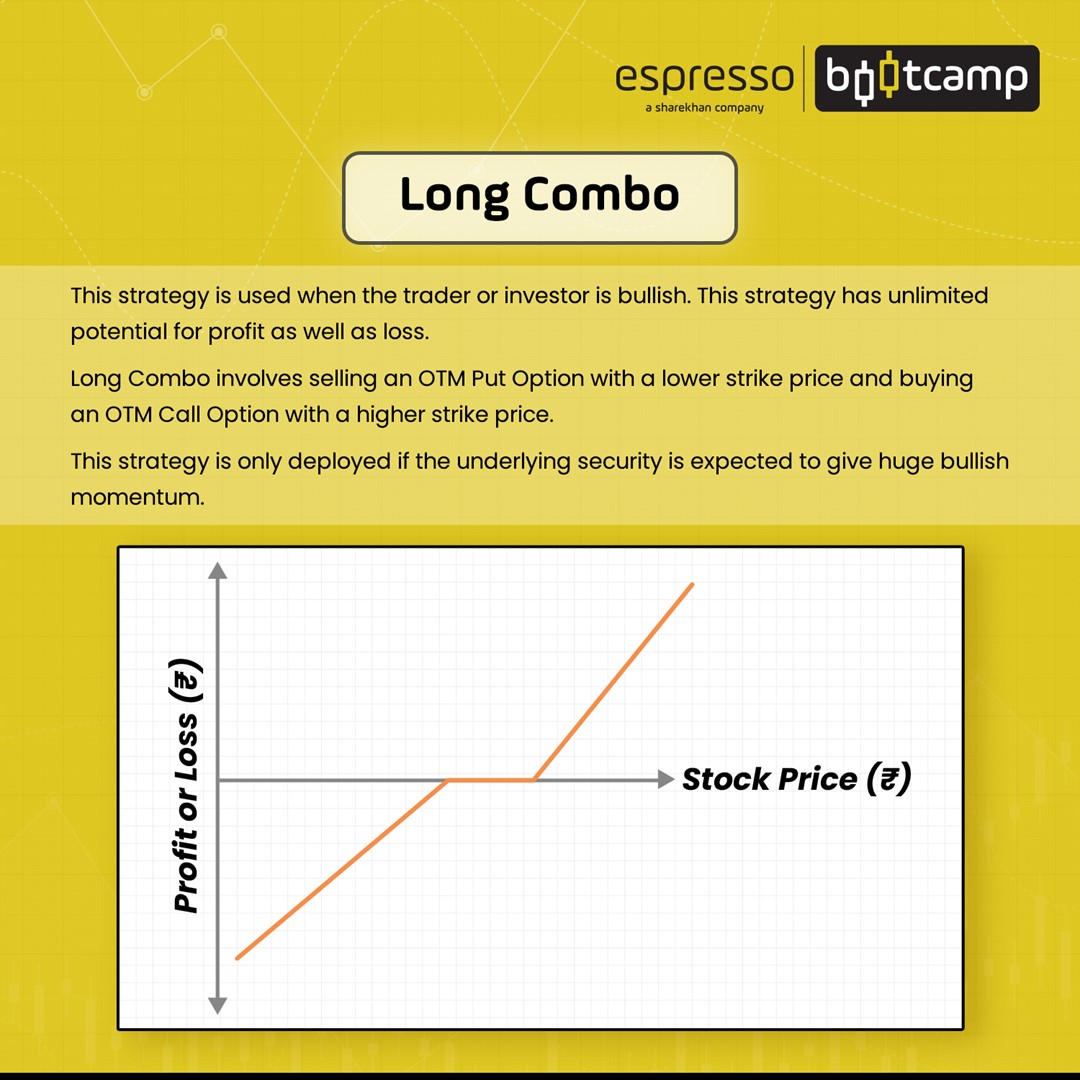
Synthetic Call
An options strategy called a synthetic call is developed by using stocks in the cash market or futures along with a put option. The combination gives the same result as that of a call option.
To put it differently, the investor is able to keep the benefit of unlimited profit and, at the same time keep the risks under control.
The combination performs all the functions of a call, but instead of one call option, it requires a put option and a stock or a future of the underlying.
This combination also goes by other names, such as Synthetic Long Call or Married Put or Protective Put.
Construction
The Synthetic Call is created by buying an at-the-money (ATM) Put option, and either the underlying stock of the same quantity as the lot size of the Put option or by buying a futures contract.
This strategy is very commonly used by investors who hold the shares but need downside protection in times of uncertainty. They do not want to sell their shares and be subjected to taxes and other costs or to let go of the benefit of dividends, rights issues, bonus issues, or the right to vote. In such a case, for protection from a sudden fall in the share price, the investor buys a Put option.
The put option gives the strategy insurance and protects the position against a fall.
The combination of the two positions makes it a bullish strategy, which also helps in preventing the trader from any downside move due to any unforeseen event.
The diagram below shows the payoff diagram of a Synthetic call.
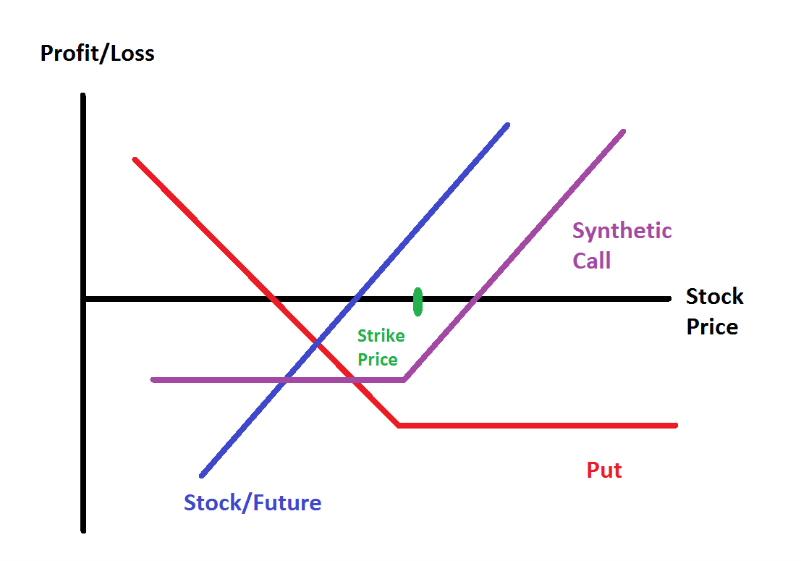
The diagram is constructed using either cash or future buying of the underlying stock and a put option.
The payoff diagram of a Put option (red) is superimposed on the payoff diagram of cash (blue) or a future (which is the same) of the underlying.
The resultant payoff diagram, named Synthetic Call, is shown in Purple.
This payoff diagram mirrors a Call option. The position has limited loss and unlimited profit potential.
Notice that the investor’s profit line of the original position (blue) has shifted towards the right when a synthetic call is created. This means that they have sacrificed some profit by buying the insurance.
However, the investor has locked the downside losing position by buying the Put option.
Here the investor is sacrificing some of the profit by buying the put option but is gaining from limited downside risk.
The breakeven point of the Synthetic Call is the point at which the stock or the future crosses the cost of buying the put.
Conclusion
A synthetic call strategy is a hedging strategy and is used to protect the portfolio from a sudden fall. The cost of protecting the portfolio is equal to the cost of buying the put option.
Synthetic Put
Just like a Synthetic Call option strategy, a Synthetic Put option strategy can be created using a combination of stock or futures and options.
Construction
A synthetic put is created by combining a short future or stock position and a long call option trade of the same underlying.
Combining the two instruments represents a long put option trade.
The Synthetic Long Put is also called a Married Call or a Protective Call.
Since in India selling the cash short is not widely used, we shall create the strategy using a Short Future Trade and buying a Long Call.
The trade is created by a trader who is holding a short position but does not want to liquidate it even if the market can show a temporary bounce.
The trader buys an at-the-money (ATM) call option of the same underlying on which his short future position is open.
The purpose of buying the call option is to only protect the short future position.
This is the insurance the trader buys to protect against any upward move.
The payoff diagram below shows a Synthetic Put Position.
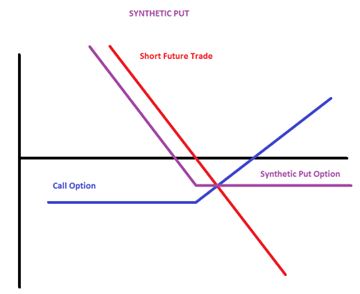
As mentioned earlier we will be creating a Synthetic Put position using futures as short selling in the Cash market in India is not widely practiced.
The short future line drawn (red) is superimposed on the long call (blue) payoff diagram. The Purple line creates the resultant payoff of a Synthetic Put.
The payoff diagram of the Synthetic Put is the same as that of a Put option.
Why create a Synthetic Put position
The primary role of a Synthetic Put option is to provide insurance cover to a short future position.
The trader holds on to his short position and uses the help of the call option to prevent his position from getting disturbed in case of a short burst that can result in a temporary mark-to-market (MTM) loss or a margin call.
However, there is another advantage that buying a call option offers to an open short position of the same underlying.
The collateral benefit is in terms of releasing capital.
Buying insurance for a short future position caps the risk to the trade. Since the risk is capped, the exchange releases the margin from the future trade, which helps the trader use the released capital to take another trade.
Note the margin required for creating a short Nifty Future trade by using the margin calculator.
The total margin required is Rs 106,048 to have the position open.
In order to create a Synthetic Put position, the trader will buy a call option. In this case, see the effect on the margin when an at-the-money (ATM) call option is added.
Here, we will add a Nifty 17300 Call option of the same expiry.
The combined margin of the two positions has fallen from Rs 106,048 to Rs 19,415. Just by buying an ATM call option the trader has now freed a margin and can now use a saving of Rs 86,633 (Rs 106,048 - Rs 19,415).
Conclusion
A Synthetic Put strategy is created to provide insurance cover to a short position. A collateral benefit of creating the position is the release of capital which the trader can use to create more such positions or take any other trade while the Synthetic Put exists.
Long Combo
Another combination that is used to mimic a portfolio that has unlimited profit and loss potential is a Long Combo. The variation here is that the Long Combo offers a no-profit-no-loss zone.
The Long Combo is a bullish strategy created by a combination of a call and a put option.
Construction
The Long Combo is created by using a Call and a Put option.
The trader sells an out-of-the-money (OTM) Put option and also adds an OTM Call.
The diagram below shows the Payoff diagram of a Long Combo strategy.

The Long Combo was created by selling a 17000 Put option (OTM) and simultaneously buying an OTM Call option – a 17600 Call of the same underlying (Nifty) and same expiry (October).
Notice the flat range between the two slopping lines. This range offers the investor some insurance for his portfolio in case the market remains flat or falls a bit. By creating the strategy, the trader now has a directionally long position with enough room to hold on to the position if the market remains flat or moves slightly lower.
The cost of creating this position (margin) is lower than buying a future. Further, the strategy offers enough legroom if the trade does not perform and allows the trader to benefit from any up move.
Conclusion
The Long Combo strategy is a low-cost one to create a long position and enough room for the underlying to play, without hampering the performance of the portfolio.
The strategy uses two OTM options – a Put Sell and a Long Call to create a directionally long trade. The trader can play around with the strike price to select the area where he believes the underlying can fluctuate.
 0
|
0
|
 0
0
 Modules
Modules
 Watch
Watch 
